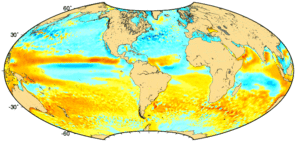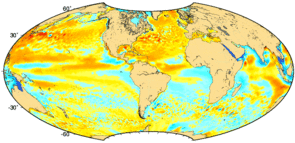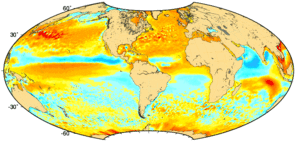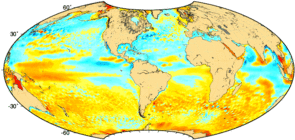Turns of the seasons in the Ocean
Depending on the season, the ocean changes, with winds or simply with external temperature. It dilates when the weather is warm, and contracts when it's cold, currents move with dominant wind direction.
Oceans have their seasons, shifted of about two monthes with respect to their atmospheric equivalents, time for water to warm up or cool down. Water dilatation and contraction due to those warming and cooling can make sea surface heights vary of about 10 cm between the coldest month (April-May in the Northern Hemisphere) and the warmest (September-October in the Southern Hemisphere)
The amplitude of the variations in sea level due to the seasons is one of Topex/Poseidon's discoveries. This shows the quantity of heat kept in stock in the ocean, and thus its impact on the climate.
Averaged over 15 years of sea level variations over Northern Hemisphere Spring, Fall, Summer and Winter (from left to right and top to bottom). The water warms in Summer, and cools in Winter, thus explaining a difference of about + or - 10 cm in the sea level between the seasons, with the seasons being inversed in the Northern and Southern Hemisphere.
Moreover, ocean stays warm or cold for some time, with a roughly two months delay with the calendar seasons, thus explaining the highs or lows in Fall or Spring.
Further information :
- Image of the month, May 2007 : Turns of the seasons in the Ocean.
- Lively Data :
- August 17, 2005, The seasons of the Gulf Stream.
- February 18, 2004, North Atlantic sea level heights over time.
- August 11, 2003, Four seasons in the Atlantic.
- Aviso Newsletter #4, 1996, Seasonnal variations in sea level variability, JF Minster.









